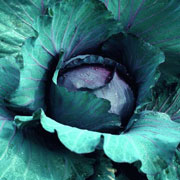


Home
Flowers &
Indoor Plants
Fruits & Nuts
Ornamentals
Vegetables
Special Topics
Resources
Glossary

Cabbage |
 |
What about it? Cabbage is a member of the mustard family and therefore related to turnips, watercress, and radishes. In fact, broccoli, kale, Brussel sprouts, kohlrabi, and cauliflower are different varieties of the same species. There are many types of cabbages to choose from: green, red, Chinese, early maturing, etc. Chinese cabbage comes in the heading or the non-heading (Pakchoi) varieties. There are also cabbages for all seasons, including the late-fall types for fresh green lovers. What is it used for? No matter which one you choose, all cabbages are rich in vitamins A, C, and K. The leaves of the cabbage plant are edible. They wrap around one another to form a "head." The inner leaves are protected from the elements and are much more tender than the outer leaves. Where does it grow? How do we grow it? Cabbage is normally planted as a transplant and may take 50 to 70 days to reach harvest size. They prefer cool weather, especially during the critical head formation period. Too much heat at this time can greatly lessen the quality of your cabbage. What are its primary problems? As mentioned above, cabbages are highly susceptible to heat It is important to watch out for aphids, cabbageworms, cabbage loopers, flea beetles, and cabbage root maggots. Plants are prone to Altemaria leaf blight, clubroot, downy mildew, and white mold. Marigolds and anise planted in the cabbage rows may reduce the number of cabbageworms. How do we propagate it? Cabbages are planted as a transplant. Get the beds ready 2-3 weeks beforehand with a big heap of compost. The best time to plant your transplant is on a cloudy day to avoid too much stress on the young plant. How do we harvest and store it? Time of harvest depends upon the weather. Size is usually the best way to judge whether a cabbage can be picked. Optimum sizes for particular varieties are given on the seed packet, but usually softball size is good. Heads should be hard and solid to the touch, and surrounded by wrapper leaves, at harvest time. The wrapper leaves provide support for the head. Cut the heads off just above the root crown with a sharp knife. Take the rosette leaves along with the head and handle these outer leaves only. Soak the head in water or salt water to remove any hiding worms and soil particles. Keep the cabbage at 32 degrees F. The leaves will quickly wilt if not kept cool and moist. The best storage conditions are in a plastic bag in a refrigerator.
© Copyright, Department of Horticulture, Cornell University. |

